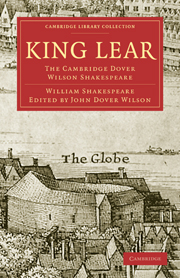INTRODUCTION
Published online by Cambridge University Press: 07 September 2010
Summary
Sources and Date
The story of King Lear and his daughters is a very old one, and it had been told by many writers before it supplied Shakespeare with the main plot of his mightiest tragedy. Shakespeare apparently knew four renderings of the tale. He knew it as it is chronicled in the pages of Holinshed. He knew it as it is told in the second book of The Faerie Queene. He knew it related—as coming from the mouth of the youngest daughter, after her death—by John Higgins in the Mirror for Magistrates. And he knew it already presented in dramatic form, by a playwright whose identity we do not know, as The True Chronicle History of King Leir, and his three daughters, Gonorill, Ragan, and Cordella.
The reader who wishes to go into the question of the relationship between Shakespeare's play and its sources should consult first the beautiful and too little known lecture on the subject by R. W. Chambers, and for details an article published in The Library by Sir Walter Greg in 1940. Greg lists some two score parallels between Shakespeare's version and the Leir play. It would, seem, as he says, that, as Shakespeare wrote; ‘ideas, phrases, cadences from the old play still floated in his memory below the level of conscious thought, and that now and again one or another helped to fashion the words that flowed from his pen’.
- Type
- Chapter
- Information
- King LearThe Cambridge Dover Wilson Shakespeare, pp. ix - lvPublisher: Cambridge University PressPrint publication year: 2009First published in: 1960



